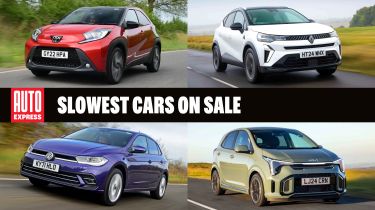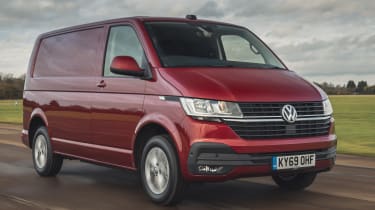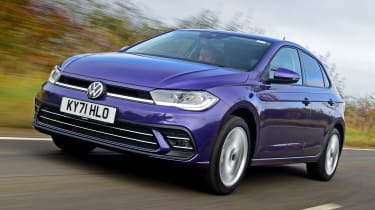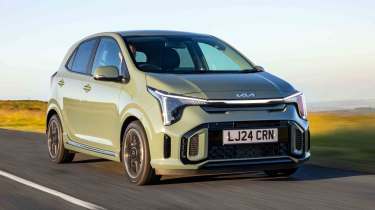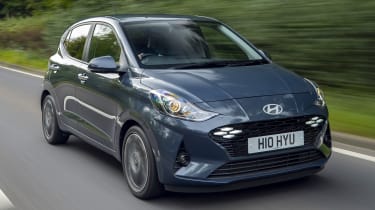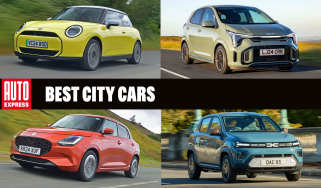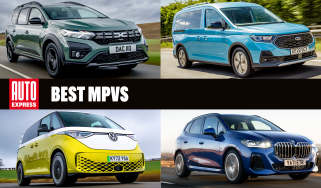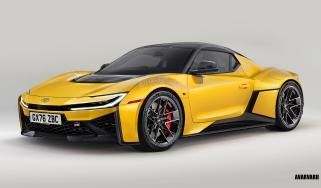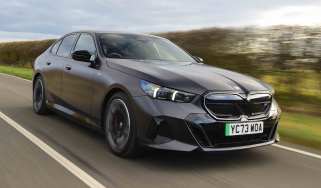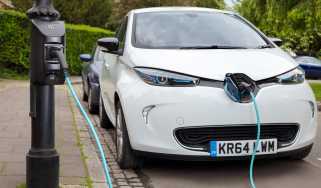Slowest cars on sale now
Sometimes it’s good to sit back and enjoy the journey, and the cars on our list of the slowest-accelerating new models give you plenty of time for that.
We often use a car’s acceleration time from 0-60mph or 0-62mph as a way to show its performance, but in reality there are few opportunities to go from a standstill to A-road speeds in one burst. This benchmark of performance may seem irrelevant, then, but it does allow comparisons to be made and will show you which cars you can expect to be fast in terms of acceleration and which are among the slowest cars on sale in the UK.
The models on this list of the slowest new cars take leisurely performance to the next level, in some of them you may even find it difficult to keep up with the flow of traffic on faster roads. Quick exits from busy junctions are likely to be stressful, and any overtaking manoeuvre on a lorry, tractor or even a cyclist may need extra forward planning, perhaps even some bravery.
The 0-60mph dash, or 0-62mph as quoted by most car makers, is a definitive measure of a car’s performance. The lower the number, the faster it goes from a standing start to the legal limit. However, on crowded roads and with the cost of fuel, slower can be better.
The cars in our top 10 of the slowest accelerating new models on sale in the UK take this approach to its slothful conclusion. These cars are so laid back in their get up and go that they could struggle to keep up with the flow of traffic.
However, choosing the tortoise over the hare has other benefits. The cars in our list will be cheaper to insure than their swifter counterparts, and they all offer low running costs. They also happen to be among the least expensive models in each of their respective ranges yet don’t scrimp on safety kit.
If most of your driving is around town, then these leisurely cars could be the slo-mo picks you’re after.
10. Renault Captur TCe 90
- Prices from £21,395
- 0-62mph time of 14.9 seconds
Renault goes to two extremes with its Captur small crossover. On the one hand, you can have it with zippy E-Tech full hybrid power that packs 143bhp. Or, you could slow things right down by choosing the TCe 90 model with its 999cc three-cylinder engine. Take the latter option and the Captur is almost four full seconds slower for the 0-62mph benchmark sprint.
You’ll notice the lack of urgency with the TCe 90 out on the open road, too, compared to the E-Tech model. However, thanks to the 1.0-litre petrol engine’s sweet nature, it does pull keenly through its six-speed manual gearbox and it’s happy around town where it also delivers decent fuel economy. In mixed driving, you can look forward to getting very close to the claimed 47.9mpg official figure.
10. Toyota Aygo X 1.0
- Prices from £16,140
- 0-62mph time of 14.9 seconds
Toyota has plenty of form with small, light cars that make the most of what they have to eke out as many miles as possible from each gallon of fuel. The Aygo X is very much in that mould thanks to its kerb weight of only 945kg in its simplest form. With a modest 71bhp to power it along, it’s as well the Aygo X also has good aerodynamics so it can cruise happily when it does eventually reach a higher speed.
Strangely, the Toyota Aygo X with the five-speed manual gearbox is slower than the version fitted with automatic transmission. Go for the auto and the 0-62mph time tumbles to a mere 14.8 seconds. Okay, you’re going to need a stopwatch to tell the difference, but the manual is also is 2mpg more fuel efficient and emits less carbon dioxide. At this level, small differences can have a big influence on which car you choose.
8. Ford Tourneo Connect 1.5 EcoBlue 100 auto
- Prices from £33,820
- 0-62mph time of 15 seconds
We love a trier, and the Ford Tourneo Connect is one of the most versatile and hard-working people carriers you could hope to drive. Sliding side doors make it so easy to get the kids in and out, with no fear of bashing the doors on multi-storey car park pillars. The interior is also perfectly adapted to family life and the Tourneo Connect is also good to drive, as we’d expect from a Ford.
The one fly in that ointment, however, is the sluggish acceleration of the Ford Tourneo Connect. Opt for the more powerful petrol engine and it’s just the right side of okay, but this diesel engine coupled with the automatic transmission blunts forward motion. However, it’s very comfortable, so you do have somewhere to sit back and wait for the Ford to gather momentum.
7. Volkswagen Transporter Shuttle 2.0 TDI 110
- Prices from £55,231
- 0-62mph time of 15.5 seconds
There’s a strong argument in favour of the Volkswagen Transporter Shuttle not needing to be any faster. As a car designed to carry lots of people in comfort, the last thing the driver wants is to jiggle the occupants around with nippy acceleration and rapid cornering, although the VW can cope with bends in a solidly controlled fashion.
Let the Transporter Shuttle get on with smoothing out gnarly roads and you can enjoy the elevated driving position, excellent all-round vision, and strong refinement. Even when you work the 2.0-litre turbodiesel engine hard to give its best shot at acceleration, it’s not rowdy, although you do know it’s trying. With a lighter right foot, you’ll see fine fuel economy from the 108bhp motor.
6. Volkswagen Polo 1.0 80
- Prices from £21,210
- 0-62mph time of 15.6 seconds
The Volkswagen Polo enjoys a reassuringly expensive image, but you can have this superb small car for less than you think if you opt for the 79bhp 1.0-litre model. The neighbours will never know you’ve saved a few quid as the Polo is a handsome car in any of its various trim options. It’s also equipped with lots of safety kit and even the base Match comes with alloy wheels, rear parking sensors, and air conditioning.
The 79bhp 1.0-litre engine only gives itself away when you head beyond city limits. In town, it’s smooth and peppy up to 40mph, so you don’t have to stress the motor or yourself for local trips. On faster stretches, that 0-62mph means you will be left behind by most cars as you join a motorway, but combined fuel economy of more than 50mpg goes a long way to compensating for that. So does this Polo’s low insurance rating and carbon dioxide emissions.
5. Skoda Fabia 1.0 MPI 80
- Prices from £20,295
- 0-62mph time of 15.7 seconds
The Skoda Fabia is another of the wider Volkswagen Group to appear in this list, which could make you think they are more interested in sloth than performance. However, even with an engine that does without a turbocharger and offers just 79bhp, the Fabia still feels like a very good small car, which it is. Low insurance and running costs make it an ideal small-family car, and also one for new drivers to get to grips with driving solo.
Comfort is a big feature of the Fabia and it rides with a gracious quality that many larger cars cannot match. This means it’s a little easier to overlook the (very) modest performance as you glide over most bumps in the Skoda. It’s also quiet at motorway speeds, unless you encounter a steep hill and have to drop a gear or two to avoid slowing to the same pace as trucks in lane one.
4. Renault Trafic Passenger Blue dCi 110
- Prices from £48,410
- 0-62mph time of 16.5 seconds
A big car and modest engine power are the perfect combination to do well, if that’s the right term, in this list and the Renault Trafic Passenger has both elements sorted. Based on the Trafic van, the Passenger model is an MPV par excellence thanks to the huge amounts of space it provides for people and luggage. Its only real rivals are the Ford Transit Connect and the Volkswagen Transporter Shuttle, which also makes an appearance in this top 10.
Even with its lowly 109bhp output from the 2.0-litre turbodiesel engine and a 0-62mph time in which you could make a cup of tea, the Trafic Passenger still makes a case for itself; find another car that can carry up to nine people in real comfort while promising more than 40mpg. It helps that the engine delivers its peak pulling power of 258lb ft at just 1500rpm, so you don’t need to rev the engine hard to get the best from it.
3. Kia Picanto 1.0 62 auto
- Prices from £15,595
- 0-62mph time of 18.2 seconds
The Kia Picanto has form when it comes to our pick of the slowest-accelerating new cars. Now, it has moved up the rankings from fourth in 2021 to third-spot now. This is due to the latest Picanto being offered with an even less pokey 61bhp in place of the previous 66bhp 1.0-litre engine. Pair it with an automatic gearbox and 0-62mph now takes a heel-dragging 18.2 seconds compared to the previous versions’ comparatively sprightly 16.6 seconds.
It’s true this version of the Picanto feels lethargic at anything above town pace, but for those who need a city car with an automatic gearbox it’s a good bet. The Kia is very well put together, has plenty of luxury and safety kit, and even in entry-level 2 trim you get air conditioning, electric front windows, and rear parking sensors.
2. Hyundai i10 1.0 63 auto
- Prices from £15,530
- 0-62mph time of 18.4 seconds
The Hyundai i10 is closely related to the Kia Picanto, so it’s no surprise the two are closely stacked in this list of low-speed motors. However, the Hyundai manages to be even more leisurely off the mark than the Kia, recording an official 0-62mph time of 18.4 seconds to the Kia’s 18.2 seconds. This is despite Hyundai quoting the i10 with a fraction more power - 62bhp versus the Picanto’s 61bhp - although the two share the same engine.
Fitting the automated manual transmission to this engine is what really takes the sting out of any performance hopes you might have had. With the standard five-speed manual, the i10 is nearly three seconds quicker over the 0-62mph sprint, but for some drivers the choice of an auto ’box will triumph over nippier acceleration. There are some upsides to this laid-back choice, such as low insurance costs, good fuel economy, and even the Advance trim has cruise control, electric windows, and air conditioning as standard.
1. Dacia Spring 44bhp
- Prices from £14,995
- 0-62mph time of 19.1 seconds
Dacia may have chosen to call its keenly priced new small EV Spring, but if you opt for the least powerful version it certainly doesn’t have any of that bounce in its step. With the 33kWh battery, the Spring has just 44bhp on hand to get it up and going, which also makes it one of the least powerful new cars you can buy.
However, the Dacia Spring is not meant to be a motorway. Rather, it’s all about slipping through town with the minimum of fuss and cost, which this electric car certainly does thanks to a starting price where you’d struggle to find a decent used EV. The Spring also looks good and if you really must get going a bit quicker there’s a 64bhp version that ticks off 0-62mph in 13.7 seconds. Whichever version you choose, they both offer a combined driving range of 140 miles on a full charge.
The slowest cars
| Rank | Car | Overall rating | 0-62mph time |
Price from |
| 10 | Renault Captur TCe 90 | 4.0 | 14.9 seconds | £21,395 |
| 10 | Toyota Aygo X 1.0 | 3.5 | 14.9 seconds | £16,140 |
| 8 | Ford Tourneo Connect 1.5 EcoBlue 100 auto | 4.0 | 15 seconds | £33,820 |
| 7 | Volkswagen Transporter Shuttle 2.0 TDI 110 | 4.5 | 15.5 seconds | £55,231 |
| 6 | Volkswagen Polo 1.0 Evo 80 | 4.0 | 15.6 seconds | £21,210 |
| 5 | Skoda Fabia 1.0 MPI 80 | 4.0 | 15.7 seconds | £20,295 |
| 4 | Renault Trafic Passenger Blue dCi 110 | 4.5 | 16.5 seconds | £48,410 |
| 3 | Kia Picanto 1.0 62 auto | 4.0 | 18.2 seconds | £15,595 |
| 2 | Hyundai i10 1.0 63 auto | 4.0 | 18.4 seconds | £15,530 |
| 1 | Dacia Spring 44bhp | 4.5 | 19.1 seconds | £14,995 |
Fancy something small? These are the best city cars to buy...
